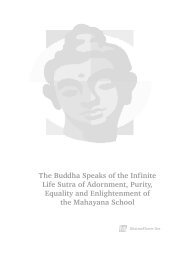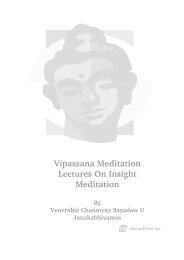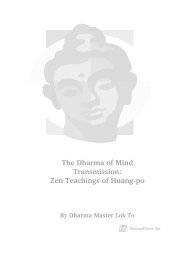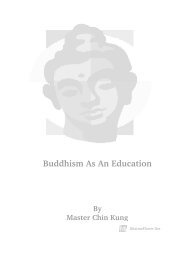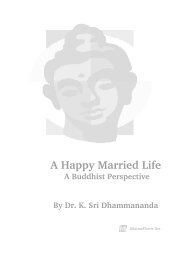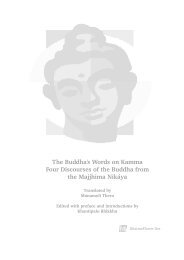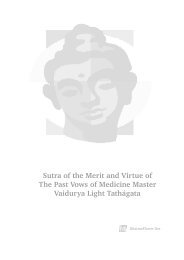THE FOUR NOBLE TRUTHS By Ajahn Sumedho - DharmaFlower.Net
THE FOUR NOBLE TRUTHS By Ajahn Sumedho - DharmaFlower.Net
THE FOUR NOBLE TRUTHS By Ajahn Sumedho - DharmaFlower.Net
Create successful ePaper yourself
Turn your PDF publications into a flip-book with our unique Google optimized e-Paper software.
Actually, the Buddha’s statement was a very accurate, preciseteaching. It is the perfect teaching, but people cannot understand it.They tend to misunderstand and to think it comes from an egobecause people are always interpreting everything from their egos. "Iam the perfectly enlightened one" may sound like an egotisticalstatement, but isn’t it really purely transcendent? That statement: "Iam the Buddha, the perfectly enlightened one" is interesting tocontemplate because it connects the use of "I am" with superlativeattainments or realisations. In any case, the result of the Buddha’sfirst teaching was that the listener could not understand it andwalked away.Later, the Buddha met his five former companions in the Deer Park inVaranasi. All five were very sincerely dedicated to strict asceticism.They had been disillusioned with the Buddha earlier because theythought he had become insincere in his practice. This was becausethe Buddha, before he was enlightened, had begun to realise thatstrict asceticism was in no way conducive towards an enlightenedstate so he was no longer practising in that way. These five friendsthought he was taking it easy: maybe they saw him eating milk rice,which would perhaps be comparable to eating ice cream these days. Ifyou are an ascetic and you see a monk eating ice cream, you mightlose your faith in him because you think that monks should be eatingnettle soup. If you really loved asceticism and you saw me eating adish of ice cream, you would have no faith in <strong>Ajahn</strong> <strong>Sumedho</strong>anymore. That is the way the human mind works; we tend to admireimpressive feats of self-torture and denial. When they lost faith inhim, these five friends or disciples left the Buddha - which gave himthe chance to sit under the Bodhi tree and be enlightened.Then, when they met the Buddha again in the Deer Park in Varanasi,the five thought at first, ‘We know what he’s like. Let’s just not botherabout him.’ But as he came near, they all felt that there wassomething special about him. They stood up to make a place for himto sit down and he delivered his sermon on the Four Noble Truths.This time, instead of saying ‘I am the enlightened one’, he said: ‘Thereis suffering. There is the origin of suffering. There is the cessation ofsuffering. There is the path out of suffering.’ Presented in this way, histeaching requires no acceptance or denial. If he had said ‘I am the allenlightenedone’, we would be forced to either agree or disagree - orjust be bewildered. We wouldn’t quite know how to look at thatstatement. However, by saying: ‘There is suffering, there is a cause,there is an end to suffering, and there is a way out of suffering’, heoffered something for reflection: ‘What do you mean by this? What doyou mean by suffering, its origin, cessation and the path?’So we start contemplating it, thinking about it. With the statement: ‘Iam the all-enlightened one’, we might just argue about it. ‘Is he really



